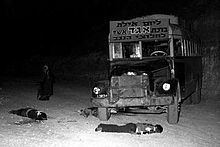Attack type Ambush Start date March 17, 1954 | Non-fatal injuries 2 Total number of deaths 11 | |
 | ||
Location Scorpions Pass, south of Makhtesh Katan Suspected perpetrators Arab gunmen from Jordan or Egypt | ||
The Ma'ale Akrabim massacre, known in English as the Scorpion Pass Massacre, was an attack on an Israeli passenger bus, carried out on 17 March 1954, in the middle of the day. Eleven passengers were shot dead by the attackers who ambushed and boarded the bus. Four passengers survived, two of whom had been injured by the gunmen.
Contents
Background
Scorpions Pass (Hebrew: מעלה עקרבים, Ma'ale Akrabim) is a narrow, winding grade on the old road connecting Eilat and Beersheba, just south of Makhtesh Katan, and roughly 60 miles south of Beersheba. The pass was on the primary route between Eilat and central Israel in 1954.
The 1948 Arab–Israeli war ended with the signing of several armistice agreements between Israel and her neighboring Arab states, but border clashes began almost immediately after the signing agreements. On the Israeli-Jordanian border lines, infiltrations, unarmed (71%) and armed (29%), were not infrequent from both sides. According to Israeli sources, between June 1949 and the end of 1952, a total of 57 Israelis, mostly civilians, were killed by infiltrators from Jordan. The Israeli death toll for the first 9 months of 1953 was 32. Over roughly the same time (November 1950 – November 1953), the Hashemite Kingdom of Jordan/Israel Mixed Armistice Commission (HJK/IMAC) condemned Israeli military reprisal actions 44 times and claimed that it suffered 629 killed and injured from Israeli incursions. Similar attacks, carried out largely by Palestinian commandos likely with some Egyptian support, originated from across the Egyptian border and the Gaza strip. Israel historian Benny Morris states that between 1949 and 1956 between 200 and 250 Israelis were killed by infiltrators and a similar number of Israeli soldiers were killed in action. Other sources give a total of 1,300 killed over this period. Many Palestinians died during the infiltration with Benny Morris writing that “Israel’s defensive anti-infiltration measures resulted in the death of several thousand mostly unarmed Arabs during 1949-56.” A group named as the "Black Hand", composed of predominantly Bedouin from 'Azazme and Tarrabin tribes living within the al-Auja Demilitarised zone, were known to be carrying out 'revenge raids' principally against other Bedouin, informers in the area but also against Israeli targets.
In the Negev, Israel embarked on development projects, which became the target of theft by Bedouins. Israeli security forces' shooting of these Bedouin had created blood feuds in the area.
The attack
On the night of 16 March, a bus operated by the Egged Israel Transport Cooperative Society on an unscheduled journey carrying 14 passengers made its way from Eilat to Tel Aviv. As it was climbing up the steep grade, it was ambushed by gunmen who shot and killed the driver as well as passengers who tried to escape; they then proceeded to board the bus and shoot and pilfer from the remaining passengers. The male driver, Efraim Firstenberg, was killed, along with eight male passengers and two female passengers. The four survivors were two Israeli soldiers, a woman, and a five-year-old girl, Miri Firstenberg (whose parents were both killed in the attack), after one of the soldiers riding the bus defended her with his body.
Tracking
The next day, Israeli trackers assisted by police dogs and accompanied by UN observers followed the attackers' tracks to a point 6 miles west of the Jordanian border, where the tracks were lost. Relying on informants, Israeli intelligence sources named 3 suspects from the Jordanian village of Safi as the perpetrators and Lt. Colonel Shalev passed the names to Elmo Hutchison. The Jordanians continued in their endeavours to discover the perpetrators of the attack.
Aftermath
Despite public outcry and call for military retaliation against Jordan, Israel's prime minister Moshe Sharett called for restraint and diplomatic measures, as less than six months before the events, Unit 101 had attacked the village of Qibya as part of Israel's retaliation policy, which resulted in the deaths of 69 people and worldwide condemnation.
Israel requested that the Jordan–Israel Mixed Armistice Commission (HJK/IMAC) denounce Jordan for the crime. Jordan's representative to the HJK/IMAC pointed out the possibility of the atrocity being carried out by Israeli Bedouin, and HJK/IMAC Chairman, Commander Hutchison abstained as there was no conclusive proof, resulting in no decision. As a result, Israel left the HJK/IMAC.
Hutchison suggested that the attackers were either Gaza Bedouin or Israeli Bedouin. John Bagot Glubb suggested that the culprits were from Gaza. This theory gained credibility when, in 1956, an ID from the Ma’ale Akrabim incident was found in Gaza. Many believe that Glubb had been right and Israel wrong, and that the Ma'ale Akrabim killers had indeed come from Egyptian-controlled territory rather than Jordan.
The Israeli Ministry of Foreign Affairs cited the Ma'ale Akrabim incident, among many others, as evidence that "major Arab terrorist attacks" preceded the 1967 Six Day War, in which Israel occupied the West Bank and Gaza Strip, to challenge what they describe as common claims by Palestinian and Arab spokesmen "that the recent Palestinian terrorism is the result of the Israeli 'occupation'". In 2007, a reconstructed bus was placed in the Eilat City Museum.
